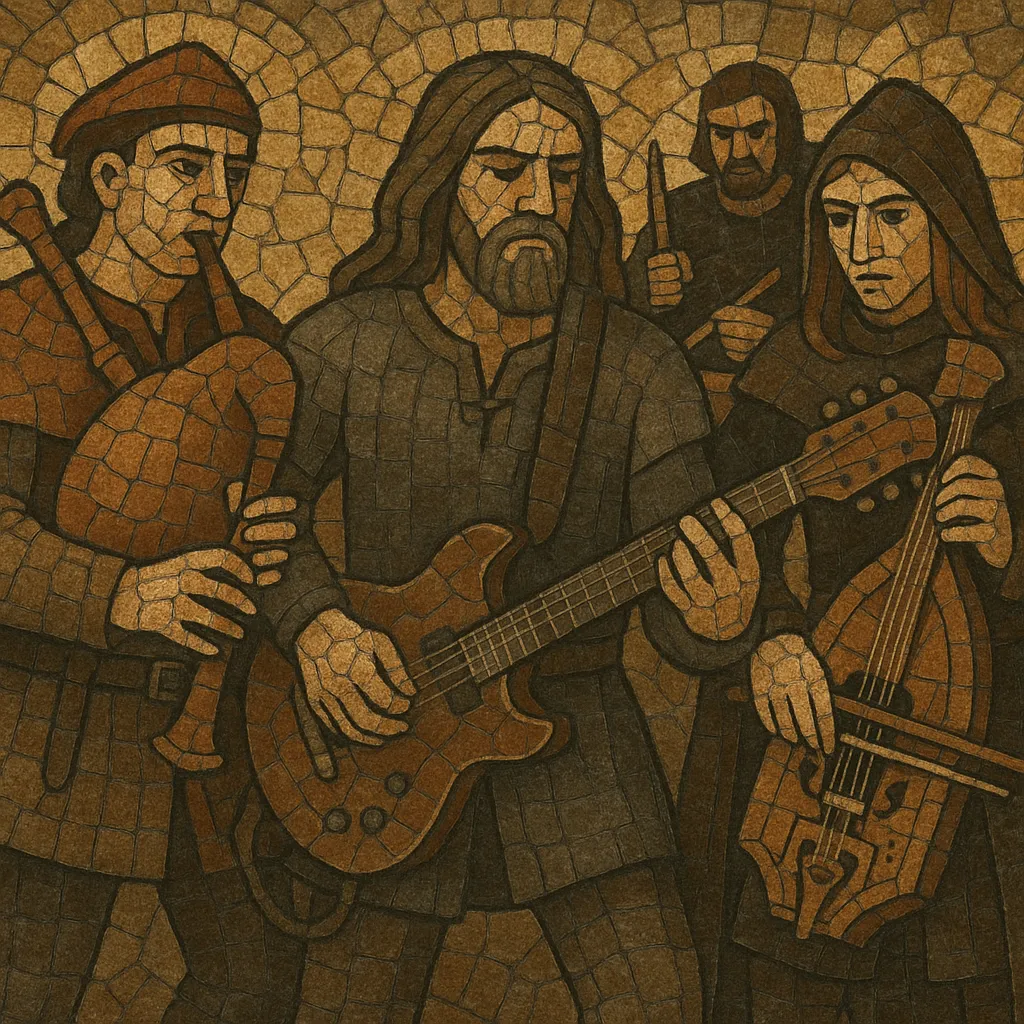Mittelalter-Rock ("medieval rock") is a German style that fuses contemporary rock with melodies, modes, instruments, and imagery associated with the European Middle Ages. Bands blend electric guitars, bass, and drum kit with hurdy-gurdy (Drehleier), bagpipes (Dudelsack), shawm (Schalmei), lute, and nyckelharpa, often performing in historical costumes and using archaic texts.
Musically, it favors modal melodies (Dorian, Aeolian, Mixolydian), danceable rock rhythms, and sing-along choruses. Lyrics are usually in German and frequently reference minstrels, legends, feasting, and chivalric or folk subject matter; occasional verses appear in Latin or Middle High German. The result is a festive, theatrical sound that sits between folk rock and gothic-tinged rock, with an unmistakably medieval color.
The genre took shape in Germany in the early to mid‑1990s when rock and folk musicians began arranging medieval tunes for modern band lineups. Groups such as Subway to Sally (formed 1992) and In Extremo (mid‑1990s) combined bagpipes, hurdy‑gurdy, and shawm with electric guitars and drums, while drawing on modal medieval repertoire and folklore. Parallel to this, the members of Corvus Corax launched Tanzwut to explore a heavier, rock‑oriented direction with the same archaic instrumentation.
By the late 1990s and early 2000s, the sound had a distinct identity: rock songcraft framed by medieval hooks, dance rhythms, and rousing choruses. Festivals and markets (e.g., large medieval fairs) provided a live circuit where these bands developed theatrical performances with pyrotechnics, historic garb, and audience call‑and‑response. Acts like Schandmaul, Saltatio Mortis, and Letzte Instanz broadened the audience, earning mainstream chart placements in German‑speaking countries and establishing “Mittelalter‑Rock” as a recognizable label.
During the 2010s, some groups emphasized a polished, radio‑friendly rock approach while others leaned into heavier metal textures, paving the way for the closely related Mittelalter‑Metal. Newer bands adopted humorous, tavern‑song aesthetics or integrated pop‑rock hooks without abandoning the signature bagpipe/organetto/hurdy‑gurdy leads. The style remains a staple of German festival culture and a gateway for audiences into both medieval folk traditions and modern rock.
Mittelalter‑Rock helped normalize the combination of early instruments with contemporary backlines, influencing the growth of Mittelalter‑Metal and sustaining a vibrant ecosystem of medieval‑themed performance in the German rock landscape.
Combine a standard rock setup (electric guitar, bass, drum kit) with medieval/folk instruments such as hurdy‑gurdy (for drones and buzzing rhythmic patterns), German bagpipes/dudelsack (as a lead hook instrument), shawm, flute/whistle, nyckelharpa, lute, or bouzouki. Let the early instruments carry the main motifs and use guitars to support with power‑chord riffs and doubling lines.
Write motifs in modal scales—Dorian, Aeolian, and Mixolydian are most idiomatic. Favor stepwise melodies with occasional fourth/fifth leaps reminiscent of medieval tunes (e.g., estampie/saltarello vibes). Use pedal drones (from hurdy‑gurdy or bagpipes) under simple triads or open fifths on guitar. Keep grooves driving and danceable: 4/4 at 95–130 BPM for anthemic choruses, or 6/8/12‑feel for jig‑like pieces. Accentuate beats 2 and 4 for crowd clapping.
Write in German, incorporating archaic vocabulary, folk imagery, and narrative storytelling about minstrels, taverns, legends, and seasonal festivities. Employ memorable, chant‑ready refrains and call‑and‑response lines; occasional Middle High German or Latin phrases add period color.
Open with a solo medieval lead (bagpipe/hurdy‑gurdy) to state the hook, then layer guitar and drums. Alternate verses with instrumental dance breaks featuring shawm/pipe riffs. Build big gang‑vocal choruses and use breakdowns with hand drums or drone textures for contrast. In the mix, capture the grit of early instruments (close mics plus a touch of hall reverb) while keeping the drum kit punchy and guitars supportive rather than overpowering the acoustic timbres.
Lean into theatrical presentation: historical attire, percussive stage elements (tabor, frame drums), audience claps and sing‑alongs, and energetic pacing that translates the festival atmosphere to the stage.


